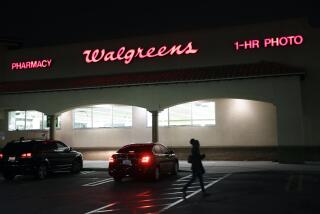Fedco to Seek Chapter 11 Protection, Close Doors
Fedco, Southern California’s first membership discount retailer, said Friday that it has filed for Chapter 11 bankruptcy protection and plans to eventually close all of its stores and lay off 3,700 employees.
Under its bankruptcy plan, Fedco would sell its 13 outlets to retail giant Dayton Hudson Corp. for about $120 million. About half those stores would be reopened as part of Dayton Hudson’s Target discount chain. The sale, which must be approved by a Bankruptcy Court judge, would bolster Target’s already sizable presence in the region.
Executives at Fedco, a nonprofit organization founded in 1948 by federal employees, said it became clear late last year that it could not afford to modernize and expand its chain of aging stores. Meanwhile, it was fighting a losing battle against numerous nationwide discount chains--including membership stores such as Costco--that have expanded into its home turf.
“As the profits dwindled because of the increased [competition], there weren’t enough proceeds to reinvest and expand the company,” said Fedco President Bob Stevenish, who led a group of Fedco managers who tried but failed to buy the 51-year-old retailer.
Stevenish said Fedco stores will remain open and employees and vendors will be paid while the firm works its way through the bankruptcy process. Upon approval by a judge, Fedco would proceed with a liquidation sale before it closes the stores and sells them to Target, which is expected to spend 12 to 18 months remodeling the properties it plans to reopen.
Fedco, which is based in Santa Fe Springs, said it expects to be able to pay off all its debts and have money left over once the proposed sale to Target is complete. Those proceeds, which could be sizable, would be granted to a Fedco charitable foundation that would focus on communities where Fedco stores are located.
A spokeswoman for Target said the chain plans to keep six of Fedco’s 13 sites and convert them to Target stores. The rest would probably be sold, said Patty Morris, though the company has not determined yet which parcels it would retain. Target operates 78 stores in Southern California.
In addition, Target would give each of Fedco’s more than 2 million customers--who paid from $2 to $10 for lifetime memberships--coupons worth $300 in discounts.
Target first came into the Los Angeles market through a similar acquisition in 1983 when it took over another troubled discount chain, FedMart.
The Fedco stores would help Target as it battles Wal-Mart Stores and other retailers that have expanded into urban markets.
Fedco’s bankruptcy “does not mean the real estate was bad, it means Fedco wasn’t serving its customers,” said Edward Weller, a retail analyst with Sutro & Co. in San Francisco.
Fedco, which sells everything from groceries to garden supplies, was established in 1948 by 800 Los Angeles-area postal workers seeking relief from a postwar wage freeze and rising prices. Each chipped in $2 to open and become members in the Federal Employees Distributing Co. The group was able to take advantage of its members’ combined buying power to get the best prices from wholesalers.
Fedco membership--initially limited to employees and retirees of the federal government--exploded from 800 to more than 50,000 in its first five years.
The rules were gradually relaxed, and Fedco eventually saw its membership swell beyond 3 million. This weekend will mark the last time those members will receive the twice-a-month Fedco Reporter, the company’s advertising circular since 1951.
Fedco’s unique retail format and membership structure were eventually copied and improved upon by rival discounters.
Fedco also failed to broaden its appeal and awareness among younger consumers and new residents. As a result, the average age of its most frequent shoppers is 62.
A new generation of privately run membership discount stores was born in 1976 when Price Club, now operated under the Costco name, opened a mammoth warehouse store in San Diego. Fedco failed to expand and modernize its stores, which were soon eclipsed by the new rivals.
State employee Clarke Robbins has been a Fedco member since 1974 and enjoyed being able to shop for a wide variety of merchandise in one location. Over the years, however, he has cut back his visits as rival discounters often undercut Fedco’s prices.
“It’s a one-stop shopping center,” said Robbins, of Temple City. “But they seemed to have lost their competitive edge.”
More to Read
Inside the business of entertainment
The Wide Shot brings you news, analysis and insights on everything from streaming wars to production — and what it all means for the future.
You may occasionally receive promotional content from the Los Angeles Times.










